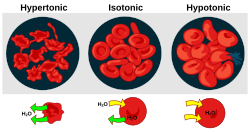User:Klarachen/sandbox
Applications
[edit]
Osmotic pressure is an important factor affecting biological cells. Osmoregulation is the homeostasis mechanism of an organism to reach balance in osmotic pressure. There are three possible tonicities in cells:
- Hypertonicity is the presence of a solution that causes cells to shrink.
- Hypotonicity is the presence of a solution that causes cells to swell.
- Isotonicity is the presence of a solution that produces no change in the cell volume.
Hypotonicity and Its Function
[edit]When a biological cell is in a hypotonic environment, water flows across the cell membrane into the cell and accumulates in the cell, causing it to expand. In plant cells, the cell wall restricts the expansion, resulting in pressure on the cell wall from within called turgor pressure. Turgor pressure allows herbaceous plants to stand upright. It is also the determining factor for how plants regulate the aperture of their stomata. In animal cells, excessive osmotic pressure can result in cytolysis.
Osmotic Homeostasis to Salt Stress in Plants
[edit]Osmotic pressure is the basis of maintaining cell shape and activity in the different solute environments. For the plants in high-salt environments, a mechanism to purify water from salted water and absorb it for biological activity is necessary. A high-salt environment would result in salt stress and hence sodium toxicity in plant cells, eventually causing biophysical changes, such as reduced cell turgor pressure, cell shrinkage, and cell wall damage. There are several pathways and structural changes in plant cells as a response to salt stress:
- Salt Stress Sensation
Once salt stress is perceived by the plant cells, the Ca2+ channel is always activated to initiate the calcium signal cascade, allowing Ca2+ influx, activating reactive oxygen species signaling, and altering phospholipid composition in the cell membrane. Plant cells initiate adaptive reactions to alleviate salt stress by maintaining an ion balance and osmotic homeostasis to regulate osmotic pressure.
- Gene Osmolyte Synthesis
There are osmotic signaling pathways in plants for osmotic homeostasis to mediate gene expression and activate osmolyte biosynthesis enzymes in water transport systems. One key molecular in osmotic homeostasis is an osmolyte, the small biological molecule that regulates plants' fluid properties.[1] In response to salt stress, mRNA level of kinase proteins, such as MAPKKK, MAPKK and MAPKs would increase, stimulating osmolyte synthesis. Osmolytes, for instance, proline, polyols, and sugars accumulate in plant cells and hence lower the osmotic potential in the cytoplasm[2]. Osmotic homeostasis is then maintained.
- Cell Wall Regulation
The structural changes in plant cell walls as a result of a high-salt environment include the decreasing cellulose content, disrupted the cross-linking of pectin, and increased lignin level, which would eventually develop into cell shrinkage[3].
- Cytoskeleton Architecture Change
Salt stress and change in osmotic pressure impact cytoskeleton architecture, such as nucleation and polymerization, severing and depolymerizing, crosslinking/bundling, and growth/shrinkage[4]. As a result of salt stress, cortical microtubule would be depolymerized and reorganized to allow the Ca2+ influx, and the cytoskeleton acts as a transducer to activate the calcium signaling and hence improve salt tolerance in plants.
- ^ Zhao, Shuangshuang; Zhang, Qikun; Liu, Mingyue; Zhou, Huapeng; Ma, Changle; Wang, Pingping (28 April 2021). "Regulation of Plant Responses to Salt Stress". International Journal of Molecular Sciences. 22 (9): 4609. doi:10.3390/ijms22094609.
{{cite journal}}: CS1 maint: unflagged free DOI (link) - ^ Zhao, Shuangshuang; Zhang, Qikun; Liu, Mingyue; Zhou, Huapeng; Ma, Changle; Wang, Pingping (28 April 2021). "Regulation of Plant Responses to Salt Stress". International Journal of Molecular Sciences. 22 (9): 4609. doi:10.3390/ijms22094609.
{{cite journal}}: CS1 maint: unflagged free DOI (link) - ^ Liu, Jianwei; Zhang, Wei; Long, Shujie; Zhao, Chunzhao (23 March 2021). "Maintenance of Cell Wall Integrity under High Salinity". International Journal of Molecular Sciences. 22 (6): 3260. doi:10.3390/ijms22063260.
{{cite journal}}: CS1 maint: unflagged free DOI (link) - ^ Zhao, Shuangshuang; Zhang, Qikun; Liu, Mingyue; Zhou, Huapeng; Ma, Changle; Wang, Pingping (28 April 2021). "Regulation of Plant Responses to Salt Stress". International Journal of Molecular Sciences. 22 (9): 4609. doi:10.3390/ijms22094609.
{{cite journal}}: CS1 maint: unflagged free DOI (link)

